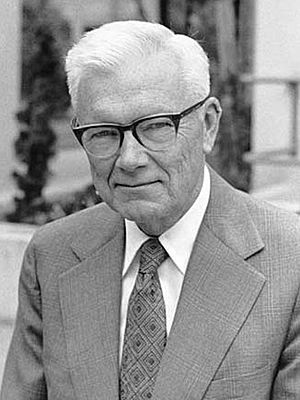Paul Flory facts for kids
Quick facts for kids
Paul John Flory
|
|
|---|---|

Flory in 1973
|
|
| Born | June 19, 1910 |
| Died | September 9, 1985 (aged 75) |
| Nationality | United States |
| Alma mater | Manchester College (Indiana) and Ohio State University |
| Known for | Polymers |
| Awards | Nobel Prize for Chemistry (1974) Priestley Medal (1974) Perkin Medal (1977) Elliott Cresson Medal (1971) |
| Scientific career | |
| Fields | Physical chemistry |
| Institutions | DuPont, Stanford University, Carnegie Mellon University, Cornell University |
| Doctoral advisor | Herrick L. Johnston |
Paul John Flory (born June 19, 1910 – died September 9, 1985) was an American chemist. He won the Nobel Prize in 1974. He is famous for his important work on polymers, which are very large molecules. He helped us understand how these big molecules behave, especially when they dissolve in liquids. His Nobel Prize was given "for his fundamental achievements, both theoretical and experimental, in the physical chemistry of macromolecules."
Contents
Paul Flory's Life and Discoveries
Early Life and Education
Paul Flory was born in Sterling, Illinois. He finished high school in Elgin, Illinois, in 1927. He earned his first college degree from Manchester College (Indiana) in 1931. Later, he received his Ph.D. from Ohio State University in 1934. His first job was at DuPont, where he worked with another famous chemist, Wallace Carothers.
Understanding Polymers
Flory's early work focused on how polymers form. This is called polymerization kinetics. Many chemists thought that the ends of growing polymer molecules became less reactive as they got bigger. But Flory showed that their reactivity stayed the same, no matter the size. He also proved that the number of polymer chains decreased very quickly as their size increased.
Flory also introduced the idea of chain transfer in addition polymerization. This helped chemists better understand how polymers grow. It also explained why polymers come in different sizes.
In 1938, after Carothers passed away, Flory moved to the University of Cincinnati. There, he created a mathematical theory for making polymers from special compounds. He also developed ideas about polymer networks, which are like gels.
In 1940, he joined the Standard Oil Development Company in Linden, New Jersey. Here, he created a theory about how different polymers mix together.
Cornell University and Key Ideas
In 1943, Flory joined the Goodyear Tire and Rubber Company. In 1948, Peter Debye invited him to give lectures at Cornell University. Flory then joined the faculty there. At Cornell, he wrote his most important book, Principles of Polymer Chemistry, published in 1953. This book quickly became a key guide for everyone working with polymers. It is still used today.
Flory introduced the idea of "excluded volume" for polymers. This means that one part of a long chain molecule cannot be in the same space as another part of the same molecule. This "excluded volume" makes the ends of a polymer chain in a liquid spread out more than they would otherwise.
Understanding excluded volume was a big step forward. It helped explain many confusing experimental results. It also led to the idea of the theta point. At the theta point, the excluded volume effect is cancelled out. This allows scientists to measure other important features of the polymer chain more easily.
He also created a way to figure out the likely size of a polymer in a good solution. He developed the Flory-Huggins Solution Theory. He also came up with the Flory exponent, which helps describe how polymers move in a solution.
For his important work, Flory received the Perkin Medal and the Priestley Medal.
Describing Molecules
Flory also created a way to describe the positions of atoms in large molecules. This is called the Flory convention. It helps scientists understand the shapes of molecules like peptide bonds by using measurements like bond lengths and angles. This method helps turn complex 3D atom positions into simpler numbers.
Later Years and Legacy
In 1961, Paul Flory became a professor at Stanford University. He retired from Stanford in 1975. He was awarded the Nobel Prize in Chemistry in 1974 for his important work on polymers. Even after retiring, he stayed active and worked as a consultant for IBM.
Paul Flory and his wife, Emily Catherine Tabor, had three children: Susan, Melinda, and John. Paul J. Flory passed away from a heart attack in Big Sur, California, in 1985.
- Flory, Paul. (1953) Principles of Polymer Chemistry. Cornell University Press. ISBN: 0-8014-0134-8.
- Flory, Paul. (1969) Statistical Mechanics of Chain Molecules. Interscience. ISBN: 0-470-26495-0. Reissued 1989. ISBN: 1-56990-019-1.
- Flory, Paul. (1985) Selected Works of Paul J. Flory. Stanford Univ Press. ISBN: 0-8047-1277-8.
See also
 In Spanish: Paul J. Flory para niños
In Spanish: Paul J. Flory para niños

